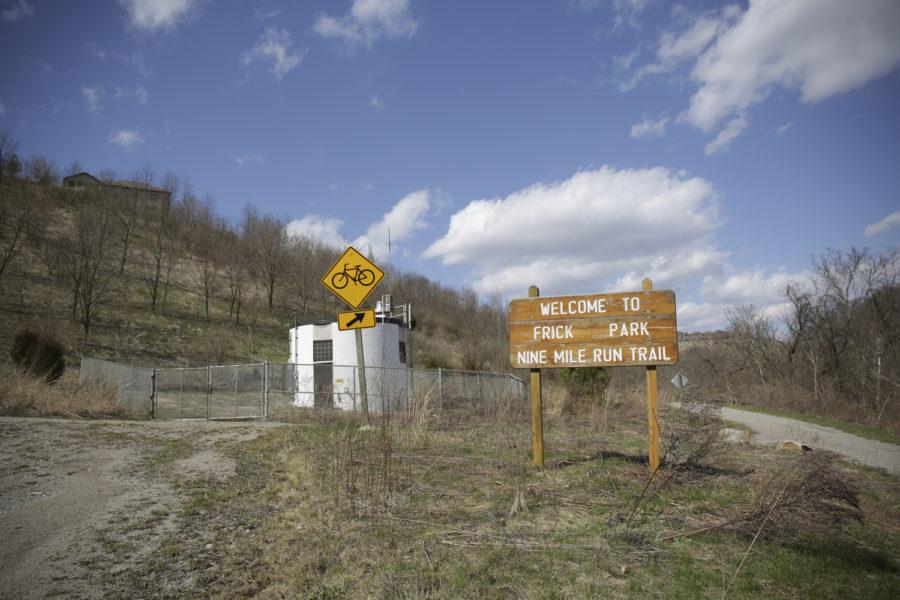There’s only one way in and out of Pittsburgh’s smallest neighborhood — a one-lane bridge marred with potholes and streaked with graffiti.
Duck Hollow was founded 140 years ago as housing for employees of the U.S. Steel Corporation and the Carrie Furnace. Situated south of Squirrel Hill on the north bank of the Monongahela River, the neighborhood was in an ideal location for workers.
Although not originally from the Duck Hollow community, Addie Massery, 22, of North Side, visits the neighborhood often to join the groups who come at night to build campfires and drink by the river.
“Everyone’s so welcoming,” Massery said. “We’ll go up to a campfire by the river, and just like that we’re friends with them because we know Duck Hollow.”
Massery said there’s a sense of self-sufficiency to Duck Hollow — large wooden boxes filled with hoses scattered throughout the neighborhood serve as a stand-in for a fire company. Massery said access to the neighborhood can be a problem for emergency services, as Nine Mile Run Creek borders the north and west sides, and the Monongahela River runs along the southern end.
“No one salts their streets. Ambulances, firetrucks don’t even know where to come for the most part. If someone is buying furniture, they have to meet the truck outside the neighborhood and carry the furniture across the bridge,” Massery said.
The secluded neighborhood also serves as a receptacle for items long forgotten, Massery said. The hill, which forms the neighborhood’s northern border, is strewn with rusted cars and rotting carousel horses. Trash accumulates at the edge of Duck Hollow from people throwing anything unwanted down the hill.
But Massery said Duck Hollow shows no signs of wanting recognition. A sign at the entrance to the neighborhood reads “Duck Hollow — Population: Just Enough.” Of the neighborhood’s three streets, two have “no outlet” signs. Massery said in the years she’s been coming to the neighborhood, she has yet to see one of its residents.
“Most of the people living here are generations of the original community,” she said.
According to 62-year-old Michael Portogallo of Swissvale, this community has existed for decades. Portogallo has been coming to Duck Hollow since the ’70s to party by the river and has seen the Pittsburgh skyline transform over time. When he first went to Duck Hollow as a teenager, the steel mill was visible across the river.
Portogallo started working at the steel mill out of high school and said Duck Hollow was a place for him and other steel workers to unwind. In the early years of his employment, he was young and had nothing better to spend his money on than the alcohol often available at the Duck Hollow riverside.
“All the guys from the steel mill would walk across the bridge after their shift was over,” Portogallo said. “There’d be 20 or 30 guys just sitting by the river, having a drink.”

Later, as employment at the steel mill declined and he lost friends to mesothelioma, Duck Hollow served as a monument to nostalgia for Portogallo. The neighborhood, tucked away behind nature trails and rail tracks, provided the perfect escape from the harsh life that accompanied steel production.
“It’s sort of bittersweet memories, being here again. Most of my friends are dead now, but I still come back,” Portogallo said.
Duck Hollow saw changes during the decline of steel as well. While Portogallo found employment tearing down the old mill, a new subdivision of multimillion-dollar homes was erected on top of the slag hills that bordered Pittsburgh’s smallest neighborhood.
But the effects of the steel mill aren’t gone for good. According to Massery, toxins from the slag seep into the creek that borders Duck Hollow. The damage to the ecosystem became so severe, the Army Corps of Engineers came to Pittsburgh to clean it up in the early ’90s.
This doesn’t stop Tom Moeller and the Three Rivers Birding Club from frequenting
Duck Hollow to birdwatch, though. Pittsburgh’s smallest neighborhood is popular with birds from all over the world, according to Moeller. He described the awe he felt seeing a kelp gull from South America only 15 minutes from his house.
“The kelp gull has only been seen in Pittsburgh on two days. It was a most rare occurrence for those of us who witnessed it,” Moeller said.
Portogallo is also drawn to the wildlife of Duck Hollow. He said now that his drinking days are over, he comes to Duck Hollow a couple times a week to train for marathons. The otters, ducks and occasional great blue heron make his runs more interesting. Between the flat trails by the rail track, scenic views and the graffitti that covers every available surface, Portogallo said Duck Hollow never disappoints — even after 45 years.
“It’s great down here. I come down here a couple times a week, and I’ve been coming here since ’85,” Portogallo said. “I see beavers and all sorts of stuff to keep things interesting on my runs.”
So much of Pittsburgh’s history can be viewed from its tiniest neighborhood, according to Massery. Yet despite all the changes, she believes Duck Hollow is the last neighborhood to maintain its charm.
“It’s one of the last raw parts of Pittsburgh,” Massery said. “It’s a calm place among everything that’s been changing so frequently.”


